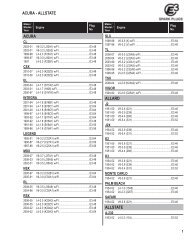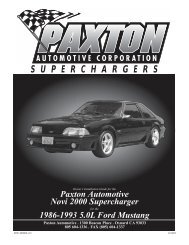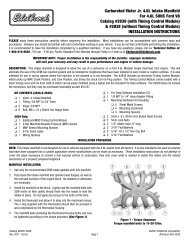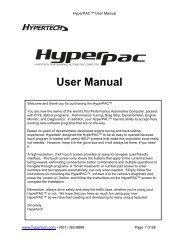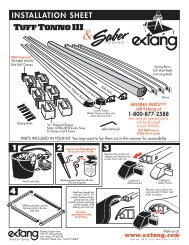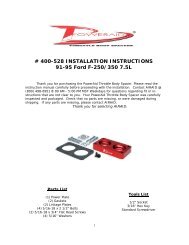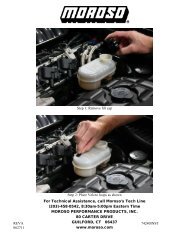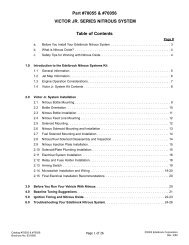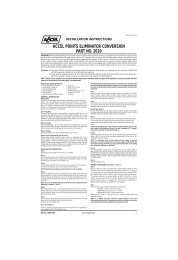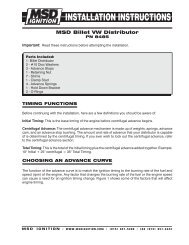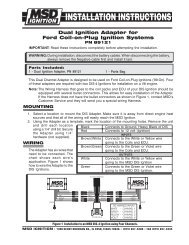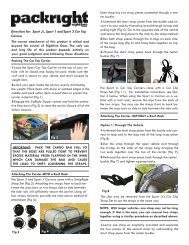NOS 05040 Nitrous System Installation Instructions - Jegs
NOS 05040 Nitrous System Installation Instructions - Jegs
NOS 05040 Nitrous System Installation Instructions - Jegs
Create successful ePaper yourself
Turn your PDF publications into a flip-book with our unique Google optimized e-Paper software.
WHAT IS NITROUS OXIDE?<br />
NITROUS OXIDE…<br />
…Is a cryogenic gas composed of nitrogen and oxygen molecules<br />
…Is 36% oxygen by weight<br />
…Is non-flammable by itself<br />
…Is stored as a compressed liquid<br />
…Exists in two grades—U.S.P. and <strong>Nitrous</strong> Plus:<br />
U.S.P. is medical grade nitrous oxide; its common use is dental and veterinary anesthesia. It is also commonly used as a<br />
propellant in canned whipped cream. U.S.P. is not available to the public.<br />
<strong>Nitrous</strong> Plus differs from U.S.P. in that it contains trace amounts of sulphur dioxide added to prevent substance abuse.<br />
<strong>Nitrous</strong> Plus is intended for automotive applications and is available for sale to the public<br />
In automotive applications, <strong>Nitrous</strong> Plus and fuel are injected into the engine’s intake manifold, which produces the following<br />
results:<br />
Lowers engine intake air temperature, producing a dense inlet charge.<br />
Increases the oxygen content of the inlet charge (air is only 22 percent oxygen by weight).<br />
Increases the rate at which combustion occurs in the engine’s cylinders.<br />
Do’s and Don’ts of <strong>Nitrous</strong> Oxide<br />
Do’s<br />
Read all instructions before attempting to install your <strong>NOS</strong> nitrous system.<br />
Make sure your fuel delivery system is adequate for the nitrous jetting you have chosen. Inadequate fuel pressure or flow<br />
will result in engine damage.<br />
Use 14 gauge (minimum) wire when installing electrical system components.<br />
Use high-quality connections at all electrical joints.<br />
Use Teflon-based paste on pipe style fittings.<br />
Make sure your engine and related components (ignition, carburetor, and driveline) are in proper working condition.<br />
If nitrous is accidentally injected into the engine when it is not running, remove the engine coil wire, open the<br />
throttle, and crank the engine 10 to 15 seconds before starting. Failure to do so can result in an explosive engine<br />
failure.<br />
Use your <strong>NOS</strong> nitrous system only at wide-open throttle and at engine speeds above 3000 RPM.<br />
Install a proper engine to chassis ground. Failure to do so may result in an explosive failure of the main nitrous<br />
supply line.<br />
Use a high-quality fuel, as suggested in Chapter 3, Baseline Tuning Suggestions.<br />
Don’ts<br />
Engage your nitrous system with the engine off. Severe engine damage can occur.<br />
Modify <strong>NOS</strong> nitrous systems (if you need a non-stock item, call <strong>NOS</strong> Technical Service for assistance)<br />
Overtighten AN type fittings.<br />
Use Teflon Tape on any pipe threads. Pieces of Teflon tape can break loose and become lodged in nitrous or fuel<br />
solenoids or solenoid filters. Debris lodged in a nitrous or fuel solenoid can cause catastrophic engine failure.<br />
<br />
<br />
<br />
<br />
<br />
Use sealant of any kind on AN type fittings.<br />
Allow nitrous pressure to exceed 1100 psi. Excessive pressure can cause swelling or in extreme cases failure of the nitrous<br />
solenoid plunger. Solenoid plungers are designed so that pressure-induced failures will prevent the valve from operating.<br />
No leakage should occur with this type of failure.<br />
Inhale nitrous oxide. Death due to suffocation can occur.<br />
Allow nitrous oxide to come in contact with skin. Severe frostbite can occur.<br />
Use octane boosters that contain methanol. Fuel solenoid failure may occur, producing severe engine damage.<br />
Chapter 1 Introduction to your <strong>NOS</strong> <strong>Nitrous</strong> Oxide Kit<br />
1.1 General Information<br />
Direct port injection style kits are intended to provide maximum performance and tunability in a nitrous oxide injection system.<br />
Horsepower increases from these kits will vary with engine displacement and configuration. However, approximate power<br />
increases can be estimated based upon the massflow of nitrous oxide into the engine. On a typical engine, the following power<br />
increases approximate what you can expect to see.<br />
4



